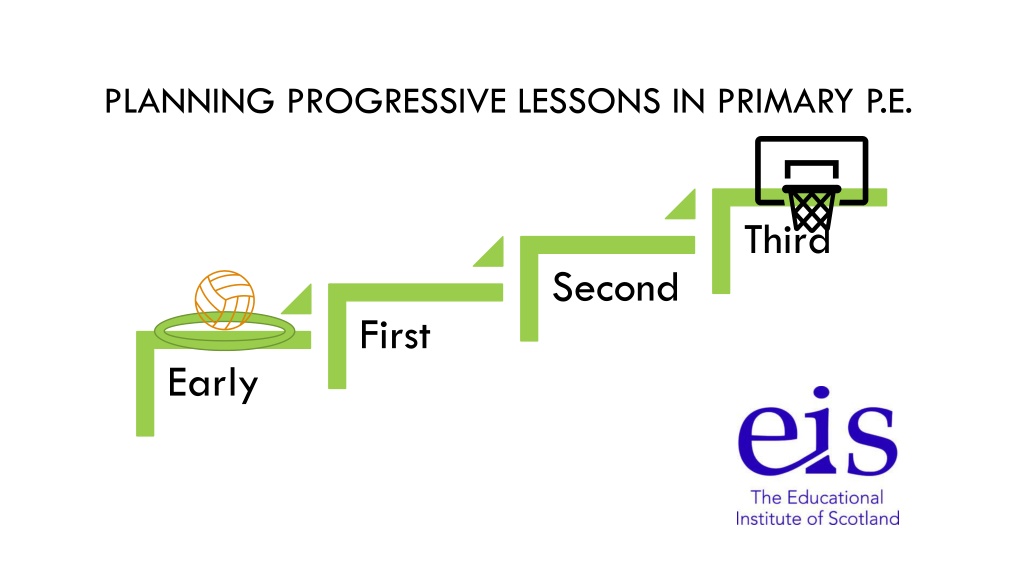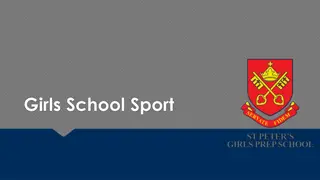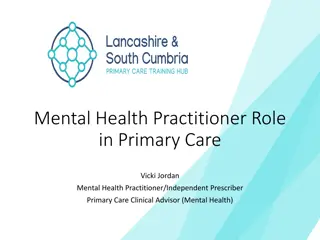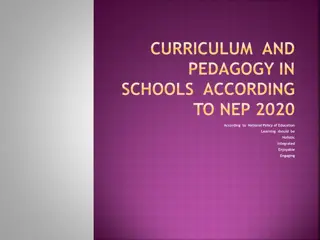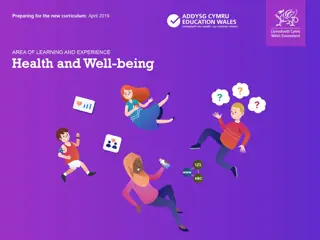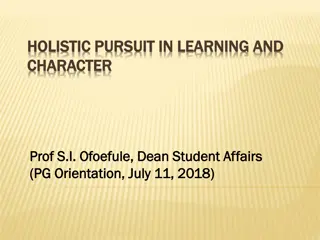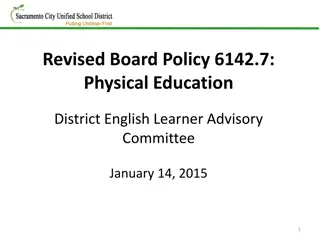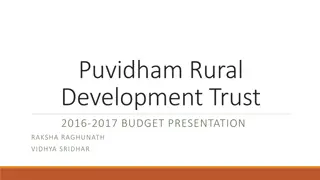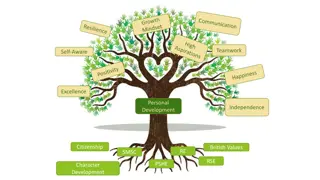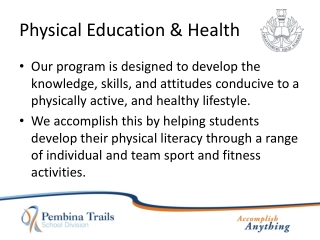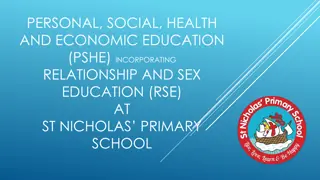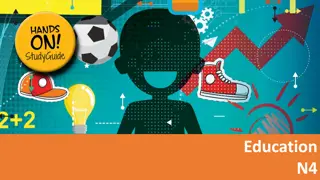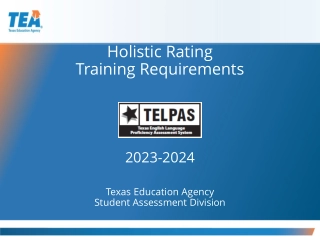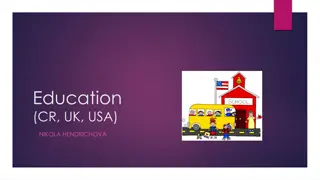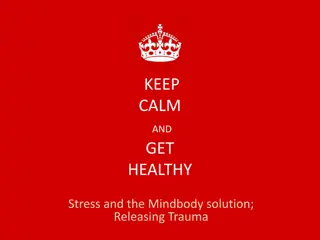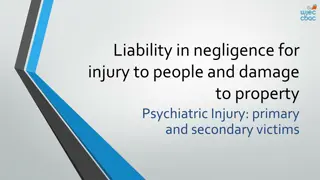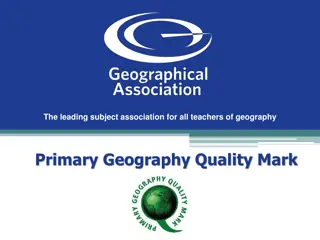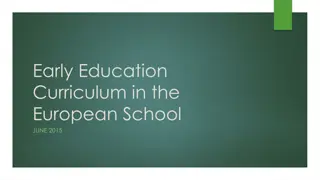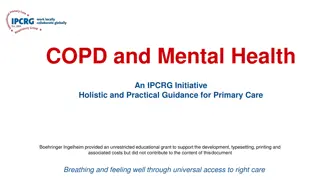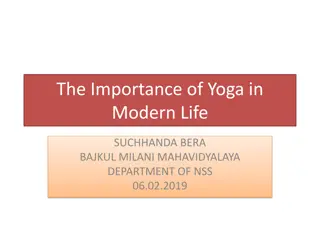Enhancing Primary Physical Education for Holistic Development
Reinforcing the educational significance of Physical Education (P.E.) in primary schools, this resource emphasizes the diverse roles of class teachers in delivering age-appropriate P.E. lessons. It aligns with the Curriculum for Excellence (CFE) and highlights the impact of P.E. progression from early stages to upper primary, focusing on fostering fundamental movement skills, mental well-being, social interaction, emotional regulation, and positive attitudes toward physical activity. The resource also underlines P.E.'s role in enhancing students' physical, social, and emotional development, preparing them for success in sports and academic transitions.
Download Presentation

Please find below an Image/Link to download the presentation.
The content on the website is provided AS IS for your information and personal use only. It may not be sold, licensed, or shared on other websites without obtaining consent from the author. Download presentation by click this link. If you encounter any issues during the download, it is possible that the publisher has removed the file from their server.
E N D
Presentation Transcript
PLANNING PROGRESSIVE LESSONS IN PRIMARY P.E. Third Second First Early
COURSE AIMS Reinforce the importance of P.E. as an educational entity delivered by GTCS registered teachers Emphasise that class teachers are the experts of their own classes and don t have to be sporty to deliver P.E. Provide a simple formats and approaches that can be used to ensure that P.E. at lessons through primary are age and stage appropriate Show examples of the impact of progressions from P1-P7 Give teachers the confidence to deliver P.E. at all stages
Curriculum For Excellence (CFE), est 2007 3-18 Broad General Education (BGE) Curriculum PE part of Health & Wellbeing: Experiences and Outcomes Nursery/P1 to S3, Levels Early, First, Second, Third, Fourth
Curriculum For Excellence (CFE), est 2007 3-18 Broad General Education (BGE) Curriculum PE part of Health & Wellbeing: Experiences and Outcomes Nursery/P1 to S3, Levels Early, First, Second, Third, Fourth
PE BENCHMARKS, EST 2017 (FORMERLY SIGNIFICANT ASPECTS OF LEARNING, 2014)
THE ROLE OF PRIMARY P.E. Provide a foundation of Fundamental Movement skills (Physical) Provide opportunities to develop core skills and knowledge in a different, physical domain. Also contributes to mental wellbeing e.g. endorphins (Mental) Provide opportunities to develop social skills, e.g. teamwork and communication (Social) Provide opportunities to test and develop emotional regulation and coping strategies (Emotional) Foster positive attitudes towards PE, Physical Activity and Sport (PEPAS) Help to raise attainment in secondary school improved base level of skills & knowledge will raise the standards/expectations in PE, more focus on higher order thinking skills in S1-3 and better equip pupils to do well in National 5 and Higher
IMPACT Identification of physical development needs, especially at early level Pupil participation in more games and activities with others during break times Increased pupil attendance at extra-curricular sports clubs More active pupils can have a positive effect in the classroom Pupils go on to succeed in sports outwith school Pupils better prepared for transition into secondary: (positive attitude to P.E.; increased competence, confidence and enjoyment of P.E. lessons; more opportunities to attend and make friends at extra curricular clubs) Raising Attainment: pupils with a better grounding of P.E. in Primary will positively impact their ability to do well in National and Higher P.E.
THE WAY FORWARD A clear definition of PE maintaining emphasis on both the Physical and Educational aspects. Quality PE is not just activity Focus on developing pupils Physical Literacy, Fundamental Movement Skills (FMS) and knowledge to enable & encourage regular participation in sport and/or physical activity Clear, simple framework/overview (skeleton) Teachers Supported by EIS and other agencies for advice and content ideas Teachers empowered to deliver lessons with autonomy, creativity and confidence
WORKING TIMETABLE EXAMPLE WORKING AREA: GYM HALL/OUTDOORS/CLASSROOM DAY 9.30-10.30 10.45-11.45 1.00-2.00 2.00-3.00 2.00-2.30 2.30-3 MONDAY P5 P6 P3 P1 P2 (9.40-10.20)* 1.10- 1.50 1.50- 2.20 (2.20- 2.50) TUESDAY P5 P6 P3 P1 P2 (9.40-10.20) 1.10- 1.50 1.50- 2.20 (2.20- 2.50) WEDNESDAY P3 P7 P4 P1 P2 (9.30-10) 1.10- 1.50 1.50- 2.20 (2.20- 2.50) THURSDAY P3 P4 P5 P1 P2 (9.30-10) (11-11.40) (1.10-2.50)* FRIDAY P4 P7 (9.40-10.20)
CALENDAR OVERVIEW (SUGGESTED) Stage Aug Sep ESSD Maths Week Scotland Oct Nov Dec Jan Feb Mar Apr May Jun Sports Week Early Travel/ locomotor Gymnastics /movement games Striking/tar get Halloween theme Strike, Catch, Strike Christmas theme Snowball dodgeball Dance/ movement to music Kick, Stop, Roll Balloons Pedal, Glide, Wheel Run, throw, jump Summer games (P1-3) P1 & 2: focus on FMS and Play. Sugg Throw and Catch Assigned Sport choice BMT Striking (Bat and ball/object) Numeracy Related Activities or Current activity with numeracy focus Parachute games Christmas target games Outdoor play (including bubbles) Building snowmen (adapted for younger classes) Curling/ winter sports Eg gymnastics problem solving, create a sum sequence First Yoga Social Dance Jump rope Rhythm activities Football (Kicking & dribbling skills) Gymnastics Volleyball Athletics (Through games) Small ball skills/ Handling Large Ball skills/ Handling (inc bounce, catch, throw) (P3-5) Combat/ martial arts Bikeability BMT Second Rugby/ NFL Basketball/ Netball Hockey Badminton Dodgeball Boccia Table games Social Dance Jump rope Rhythm activities Football Gymnastics Volleyball Athletics Softball, cricket, rounders, (P6-7) Bikeability
PHYSICAL LITERACY Physical literacy is the motivation, confidence, physical competence, knowledge and understanding to value and take responsibility for engagement in physical activities for life. The International Physical Literacy Association May 2014 www.physicalliteracy.ca
FUNDAMENTAL MOVEMENT SKILLS (FMS) Fundamental Movement skills are movement patterns that involve various body parts and provide the basis for Physical Literacy. Lindsay Broomfield, Complete Guide to Primary Gymnastics (2011) Locomotor (Body Movement) Stability Manipulative (Object Control) Throw Catch Bounce Strike (eg hockey stick, bat, racket) Balance (on head, body, bat, racket) Kick Dribble (Body Management) Roll Land Bend Stretch Turn Swing Climb Run Jump (height) Jump (distance Skip Hop Gallop Crawl Swim
PROGRESSING PE THROUGH PRIMARY P1 & 2 P3, 4 & 5 P6 & P7 P7 Focus & Approaches (suggested) FMS, Play, social games (eg parachute), TGFU, cooperative/team games, BMT, introduction to benchmarks Aesthetics (Dance, gymnastics) Outdoor learning opportunities Sport Education Sport specific skills, Cooperative learning Development of benchmark knowledge Outdoor learning opportunities Sport specific, transition to Secondary, BGE Journal/Diary P1 & 2: focus on FMS and Play. Sugg Story approach, BMT, movement to music, gymnastics Outdoor learning opportunities Frequency& Duration (suggested minimum) 4 x 30 mins per week (2 hours) 3 x 40 mins per week (2 hours) 2 x 1 hour per week (2 hours) 2 x 1 hour per week (2 hours) Outcomes/ Benchmarks Introduce concepts, develop knowledge of basic movements and words Introduction to benchmarks in LI and plenary Benchmark discussion in LI/SC and/or plenary Pupils self assess on benchmarks in BGE Journal/Diary Delivered by Class teacher led (with appropriate Support) Class Teacher led (with appropriate Support) Class Teacher Visiting Secondary PE teacher (where available for transition)
SUGGESTED LESSON FORMAT P1 & 2 P3, 4 & 5 P6 & P7 Frequency& 4 x 30 mins per week (2 hours) 3 x 40 mins per week (2 hours) 2 x 1 hour per week (2 hours) 2 x 1 hour per week (2 hours) P1 & 2: focus on FMS and Play. Sugg Duration (suggested minimum) 10 mins: pulse raiser warm up including skill development Suggested Lesson Breakdown 5 mins: pulse raiser warm up 5 mins: Pulse raiser warm up 10 mins: FMS Focus 10 mins: Skill introduction 10 mins skill development 10 mins: Game/Free play 20 mins: TGFU Game 15 mins: TGFU related to theme 5 mins: Relaxation 5 mins: Cool down/ Relaxation/Plenary 20 mins: Game (Give out PE stars) (Give out PE stars) 5 mins Cool Down/Plenary (Give out PE stars)
WEEKLY PLANNER (SUGGESTED FORMAT) DAY P1-3 P3-5 P6&7 1 Introduce Fundamental Skill focus (Allow pupils to explore the skill) Introduce the skill/Game focus TGFU approach Skills focus Game/sport related practice 2 Consolidate/Develop Fundamental Skill focus (build on prior knowledge) Consolidation of previous lesson. Reinforce and/or develop the concepts covered Reinforce previous day s focus Emphasis on small sided games 3 Social Development: Cooperate/compete with others Development of game concepts Relate to SALs 4 Free play/Game day Don t be afraid to repeat the same lesson if you think the points need more time to develop or be reinforced. Teacher judgement is key.
LESSON PLANNING: P1-3 (PLAY FOCUS) Skills focus (eg Throwing) Week/ Day Warm up Game/Application Cool Down/Relaxation Equipment needed (small ball) Individual work, Eg Hand to hand, Two hands to one hand Encourage creativity (eg pick best 3) 1 Teacher directed warm up, BMT, include jogging, skipping, sidestepping running backwards etc Throwing and Catching Knock the hat off the snowman/person Musical Catching Throw and catch the ball to yourself. When the music stops, you must have the ball in your hands. Small ball 1 each Pointy Cones 1 between 2 All pupils are snowmen with a marker on their head for a hat. Knock as many hats off without losing yours. Set number of lives Marker cones 1 between 2 Pool noodles 3-5 3 lives then put your ball away and sit down and be an extra judge. 2 Frozen tig Save the Forest (Put out the forest fires using your snowball) Ice cream cones (pupils have a cone or marker (oyster) each and have to throw and catch a snowball: 1) with a partner 2) As many partners as you can Rainbow Breaths Small ball 1 each Pointy Cones 1 between 2 3 Ice Wizards with a freeze wand (pool noodle) If you are tagged, the only way you are unfrozen is if you catch a magic snowball from a partner (Go Noodle) Marker cones 1 between 2 Trees on fire = cones with beanbags on top Throw snowball and knock beanbag off the cone Pool noodles 3-5 3 Movement to music: when the music plays run/skip/move as directed. When it stops, freeze/crouch/stand in a certain way Individual work: cone and ball, throw and catch to self or with a partner. Can you flip the ball out and catch it? Clear your garden 2 teams in a half of the hall each Throw the snowballs into your neighbours garden to make sure yours is clear! Victorious (Go Noodle) Small ball 1 each Pointy Cones 1 between 2 Marker cones 1 between 2 Pool noodles 3-5 4 Pupils choose a warm up game e.g. any tig game Free play Musical Statues Frisbees Bikes Either set out lots of equipment and pupils choose or Set up focused play zones Pupils responsible for tidying equipment. Large ball set Small ball set Hoops Beanbags Scarves Tennis bats
LESSON PLANNING: P1-3 EXAMPLE THROWING Accuracy Technique Towards a target Hit a target To a partner Right/Left/Two hand Pupils will develop their throwing skills and demonstrate application and understanding in a range of contexts Underarm/Overarm Side on position Transfer Weight Follow through Benchmarks Covered I can Work independently to throw and catch the ball Throw the ball in different ways (e.g. left/right/two hands) Throw the ball towards/accurately towards a target Throw and catch the ball with a partner Throw/catch in dynamic/pressured situations
QUALITY P.E.: QUESTIONS FOR REFLECTION Have the pupils had opportunities to: Take part in Heart/pulse raising activities? Develop/Explore Fundamental skill and movement? Apply their skills and knowledge in dynamic/challenging contexts? Physical Problem solve and make decisions? Develop confidence and individual responsibility? Explore and be creative? Mental Cooperate/share space with others? Compete against or alongside others? Communicate with others? Play? Social Regulate their emotions within a busy/dynamic/competitive environment? Play independently and/or with others? Have fun and enjoy themselves? Emotional
Fundamental Movement Skills Mental Health Cooperation Primary PE Social Competition Development Physical Health Fun! Emotional Development Play
STEP EXAMPLES SUGGESTIONS APPROACH S PACE Ensure that you are aware of and consider the health and safety requirements of the area you are working in. E.g. tables and chairs, trip/slip hazards- etc If the hall doubles up as a canteen make sure any spillages and food are cleared up. Make sure any chairs are pushed to the side to maximise the space and minimise hazards If the space e.g. gym hall is unavailable, e.g. for an assembly or other activity, have a contingency plan in place to make sure some form of PE can take place, eg YouTube, class based fitness or skills activities, adapted yoga or dance etc Go Noodle, Better Movers and Thinkers class activities, Adapted Yoga/Tai Chi Target/Table games, YouTube simulator games e.g. Coach Corey Martin, Cosmic Yoga Just Dance T ASK Have an overview of the set tasks for each week with focused learning intentions. Have a clear PE timetable and calendar so you can see which activities are being covered across the year and also to ensure a breadth of experiences. Use your pupils interests to help select activities that will help to engage them and add to the learning experiences eg Star Wars, Frozen, Mario, Marvel, Transport, Animals etc Ensure that pupils experience a broad range of skills and contexts covering a number of areas Aesthetic, team, Individual, net & rebound, invasion games etc E QUIPMENT Ensure that equipment is organised and tidied regularly in allocated spaces. This can be overseen by a member of staff or P7 pupils. Regular check/refresh of equipment where required P7 Sports leaders in charge of tidying PE cupboards Equipment divided according to type e.g. balls, shuttles, throwing equipment or stage eg early years equipment, P7 equipment etc And be creative with the equipment you use. It doesn t always have to be traditional PE equipment Paper aeroplanes or scrunched balls of paper for throwing activities Use of balloons for striking and throwing/catching Use of bubbles for outdoor activities Junkyard Olympics? P EOPLE Be aware of how many are in the class and how to organise them into pairs groups. Especially for team and group games. Circle, pairs across from each other Pupils in pairs across from each other? Or in small group circles Team games: if playing more traditional activities, what is the maximum number we can have on at any one time? E.g. 5v5 with regular rotations and observation tasks given to those sitting off. Pupils can all be sat on the bench before being given instructions (classes that need to be settled before they start) Pupils can be allowed to run to burn of energy for a couple of minutes (this may help to calm them down for instructions to be given when sat back down) Pupils can be provided with a set warm up that they have to do upon entering the Use the knowledge of your class and judgement to establish clear routines E.g. how do we start the lesson?
KEY CONSIDERATIONS Have a clear skills focus, but the context in which this is delivered is up to you Use your own interests and the interests of your pupils as the context for learning Don t be afraid to stand back and observe. Watch the class, give pupils time to explore and to problem solve. And then step in where necessary Let the pupils guide the learning. Highlight good practice or creativity and let them demonstrate to the class Plenary: ask pupils to identify Significant Aspects of Learning from the lesson and explain why Don t be afraid to repeat a lesson more than once. Use your judgement. If you think pupils need more time, trust your instincts Have fun
TAKEAWAYS Physical Literacy Primary P.E. has a massive role to play in the development and learning of our pupils, not just for school, but for life. Leave nothing to chance Keep the Physical in Physical Education The physical domain is what makes P.E. unique and special. Keep our pupils purposefully active Keep the Education in Physical Education P.E. is an educational entity and should be led and delivered by GTCS Registered Teachers (coaches etc can support, but teachers should plan and lead lessons according to Es & Os and Benchmarks) Enjoy yourself! Primary teachers are the most creative teachers there are!! Use your own interests to make it fun for all Believe! You are the specialist! You know your own pupils better than anyone
